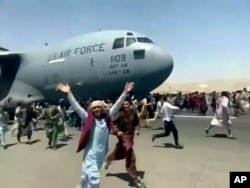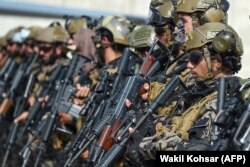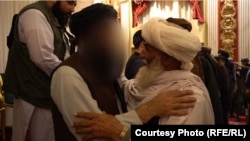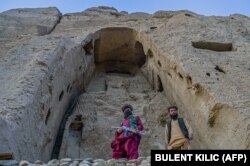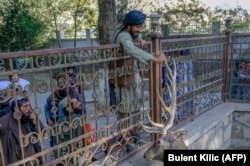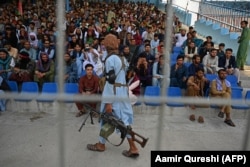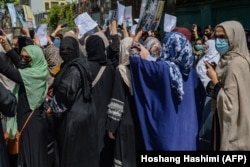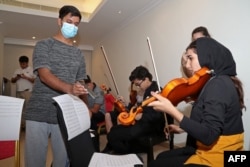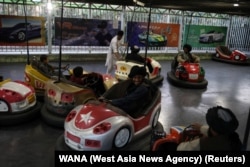The Taliban's startling return to power might not be what anyone anticipated when the year began -- aside from the militants themselves. But when it came to Afghanistan, 2021 was a year to expect the unexpected.
Plans for an orderly final withdrawal of foreign troops broke down as the Western-backed Afghan government and its security forces crumbled in the face of a fierce Taliban onslaught.
The Taliban’s military takeover of Kabul on August 15 marked the end of nearly 20 years of foreign intervention in Afghanistan during which efforts were made to cultivate women’s rights, inclusive democracy, and stability in the war-torn country.
Rushed Exit, Rapid Return
Chaos ensued as U.S. and NATO forces pulled back across the country, leaving the foreign-trained Afghan National Army (ANA) to fend off a stunning advance by the Taliban.
The ANA proved to be no match. The Taliban captured its first provincial capital on August 6. Two weeks later, Taliban fighters had reached the doors of Kabul.
As the militants surrounded the capital, President Ashraf Ghani fled the country. Hours later, the triumphant militants were holding court in the presidential palace.
Clinging To Hope
Thousands of foreigners and Afghan civilians headed to Kabul's airport, the last bastion of control by foreign forces, in the hope of being evacuated from the country.
Many were thwarted by Taliban efforts to block their escape, and scenes of desperation unfolded among the throng of people who made it to the tarmac, including some who clung to a departing U.S. cargo plane and ultimately plunged to their deaths.
To The Victor Goes The Spoils
After two weeks of mayhem punctuated by a deadly suicide attack carried out by the Islamic State-Khorasan (IS-K), the last U.S. soldier was flown out on August 30, just beating the deadline for withdrawal.
With foreign forces out of the way, the Taliban took a victory lap in U.S. and ANA military vehicles that its fighters had captured along the way.
Parade Time
The stash of military equipment acquired by the Taliban included U.S.-made armored personnel carriers and Russian-manufactured helicopters that were paraded around the capital.
Locked And Loaded
Many Taliban fighters took to wearing the uniforms and brandishing the modern equipment of their vanquished foes, including night-vision goggles, communications instruments, and assault rifles.
Flying In Style
The Taliban's leadership, meanwhile, worked to present itself as a more moderate version of the regime that was known for brutality and its strict interpretation of Shari'a law when it last ruled from 1996 until the U.S.-led invasion of Afghanistan in 2001.
As Washington sought assurances that the Taliban would prevent Afghanistan from becoming a terrorist safe haven and would uphold rights for women and girls as well as religious and ethnic minorities, Taliban negotiators appeared to get more comfortable in their role.
Blurred Lines Of Authority
Since announcing its acting government in late August, the Taliban has been less than transparent about the inclusion of some powerful figures, including spiritual leader Haibatullah Akhundzada.
While the Taliban has claimed that Akhundzada made a public appearance in October, no video or photographs of the event have emerged, fueling reports that he may have died a year ago.
And the militant group has taken steps to obscure images of other government figures, including acting Interior Minister Sirajuddin Haqqani.
Monumental Tasks
With the return of the militants came the irony that they would be the guardians of the cultural history they had attempted to erase during their last stint in power.
In December, the Taliban announced that the National Museum of Afghanistan in Kabul, where its fighters had once destroyed irreplaceable historical treasures, would be opened to visitors.
But despite assurances that its fighters would guard the site of the Bamiyan Buddhas destroyed by the Taliban in 2001, videos soon emerged of the remnants of the statues once again being used for target practice.
Taming Of The Zoo
The Taliban also set about presenting itself as the keeper of the Kabul Zoo, the former home of Marjan, the Lion of Kabul. The animal, who was left with one eye after the brother of a Taliban fighter lobbed a grenade into her enclosure in 1995, lived to become a symbol of survival for the Afghan people until she passed of old age in 2002.
While animal rights watchdogs such as the U.K.-based Wild Welfare expressed concerns about the fate of the facility under the Taliban, zoo officials offered assurances to RFE/RL's Radio Azadi that the animals were in good health and that there were plans for expansion.
Sporting Chance?
Under the previous Taliban regime, women were not allowed to play sports at all, and the participation of men was tightly controlled.
Popular sports such as cricket, soccer, and Buzkhashi had been banned on the basis that they were "un-Islamic," and playing fields were often used to stage public executions.
As athletes scrambled to get out of the country following the Taliban's return to power, the new leadership has maintained that while it is "not necessary" for women to play sports it was willing to make allowances for men.
Veiled Protests
Concerns that the Taliban would roll back gains made by women over the past 20 years sparked daily protests immediately following the militant group's takeover.
Public demonstrations for women's rights to education, jobs, and political representation have since continued despite a Taliban ban on unsanctioned rallies.
But the events have waned in number and size, and many women have taken their protests inside and online due to the threat of retribution.
Pro-Taliban female protesters also hit the streets. Many of them were draped in conservative dress, including foreign garments like the black niqab.
The Day The Music Died, Again
The previous Taliban regime had also banned music, prompting many musicians to flee the country due to fears of a return to the old policy.
While officials have been largely mute on the subject, there have been reports of musicians being harassed and their instruments destroyed. Drivers, too, have silenced their radios within earshot of Taliban checkpoints.
Amid the uncertainty, the national anthem adopted in 2006 appears to have been replaced by instrument-less religious anthems popular among the Taliban.
All Work And No Play
As the Taliban tightened its control across the country, its fighters have treated themselves to some entertainment.
Pictures have shown militants paddling in swan boats, riding on merry-go-rounds and roller coasters, and taking time out for bumper cars.






